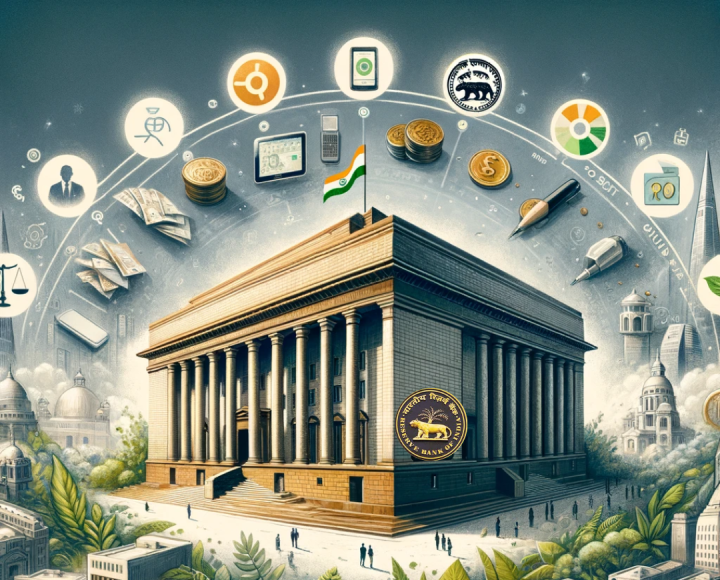The Reserve Bank of India (RBI), as the central banking authority of the country, plays a pivotal role in shaping India’s financial ecosystem. Its policies influence economic growth, inflation, liquidity, and the stability of financial institutions. Understanding the nuances of RBI’s policies is essential to comprehend how they affect businesses, consumers, and the economy at large.
1. Monetary Policy: Balancing Growth and Inflation
The RBI’s monetary policy primarily aims to maintain price stability while fostering economic growth. This is achieved through tools such as:
- Repo Rate: The rate at which banks borrow from the RBI. A reduction in repo rate makes borrowing cheaper, boosting spending and investment, while an increase curbs inflation.
- Reverse Repo Rate: The rate at which the RBI borrows from banks, used to control liquidity in the system.
- Cash Reserve Ratio (CRR): The percentage of a bank’s total deposits that must be maintained with the RBI. Adjusting CRR impacts the money supply.
- Open Market Operations (OMOs): The buying and selling of government securities to regulate liquidity.
2. Regulation of Banks and Financial Institutions
The RBI ensures the stability and soundness of financial institutions through stringent regulatory norms. Key initiatives include:
- Basel Norms Compliance: Ensuring banks maintain adequate capital to absorb risks.
- Asset Quality Reviews (AQR): Monitoring and managing non-performing assets (NPAs).
- Prompt Corrective Action (PCA): Imposing restrictions on banks with deteriorating financial health.
3. Foreign Exchange Management
The RBI manages India’s foreign exchange reserves and regulates currency exchange to ensure stability in the external sector. Key actions include:
- Exchange Rate Policy: Managing the rupee’s value against foreign currencies.
- Foreign Direct Investment (FDI) Facilitation: Simplifying processes to attract foreign investments.
- External Debt Management: Ensuring sustainable levels of external borrowing.
4. Inflation Targeting: A Crucial Mandate
Under the Monetary Policy Framework Agreement, the RBI is mandated to maintain inflation within a target range (currently 4% with a tolerance of ±2%). By adjusting interest rates and using other monetary tools, the RBI controls inflationary pressures and ensures economic stability.
5. Payment and Settlement Systems
The RBI has been instrumental in fostering innovation and security in digital payments. Key initiatives include:
- Unified Payments Interface (UPI): Revolutionizing real-time payments in India.
- NEFT and RTGS: Ensuring seamless and secure electronic fund transfers.
- Guidelines for FinTech: Supporting digital transformation while maintaining robust risk management.
6. Liquidity Management
By regulating liquidity, the RBI ensures there is adequate credit flow to productive sectors while preventing excess liquidity that could lead to inflation. Tools used include:
- Liquidity Adjustment Facility (LAF): Managing short-term liquidity mismatches.
- Market Stabilization Scheme (MSS): Absorbing excess liquidity through bond issuance.
7. Developmental Role of RBI
Beyond regulation, the RBI actively promotes financial inclusion and economic development. Initiatives include:
- Priority Sector Lending (PSL): Mandating banks to lend to sectors like agriculture, MSMEs, and housing.
- Financial Literacy Campaigns: Enhancing public awareness of banking services.
- Small Finance Banks (SFBs): Promoting credit access for underserved segments.
8. Impact on Businesses and Consumers
RBI policies have a direct impact on both businesses and consumers:
- For Businesses: Interest rate changes influence borrowing costs, while liquidity management affects credit availability.
- For Consumers: Policies impact loan EMIs, deposit rates, and overall purchasing power.
9. Crisis Management and Economic Stability
The RBI’s role during financial crises, such as the global financial meltdown of 2008 or the COVID-19 pandemic, underscores its importance. Measures like reducing interest rates, offering moratoriums, and liquidity infusions helped stabilize the economy during turbulent times.
10. Global Influence and Policy Coordination
As part of global forums like the G20, the RBI collaborates with international central banks to align policies and address global economic challenges. This ensures India’s financial ecosystem remains resilient and globally competitive.
Conclusion: The RBI’s Vital Role in India’s Economy
The Reserve Bank of India’s policies are the backbone of the nation’s financial stability and economic growth. By balancing inflation, fostering innovation, and ensuring a robust financial system, the RBI continues to shape India’s economic future. Staying informed about RBI’s policies helps businesses and individuals navigate the financial landscape effectively.
About This Blog
This blog explores how RBI policies shape India’s financial landscape. From monetary tools to regulatory frameworks, discover the central bank’s role in driving stability, innovation, and economic growth. Stay informed and make better financial decisions by understanding these crucial policies.



































